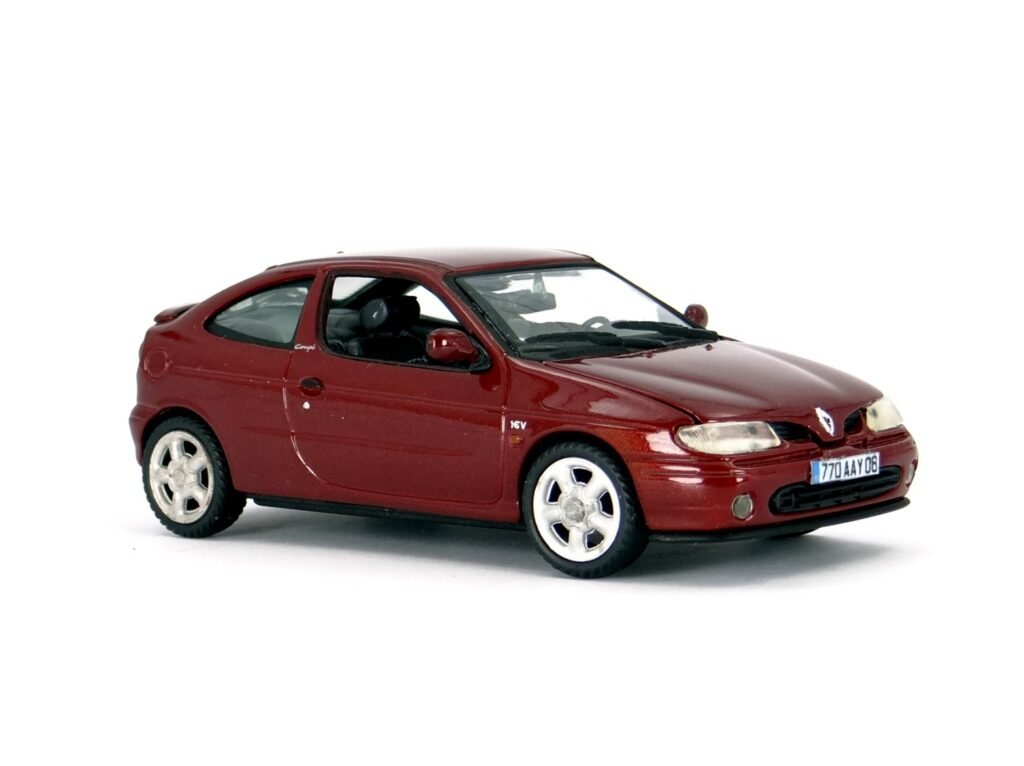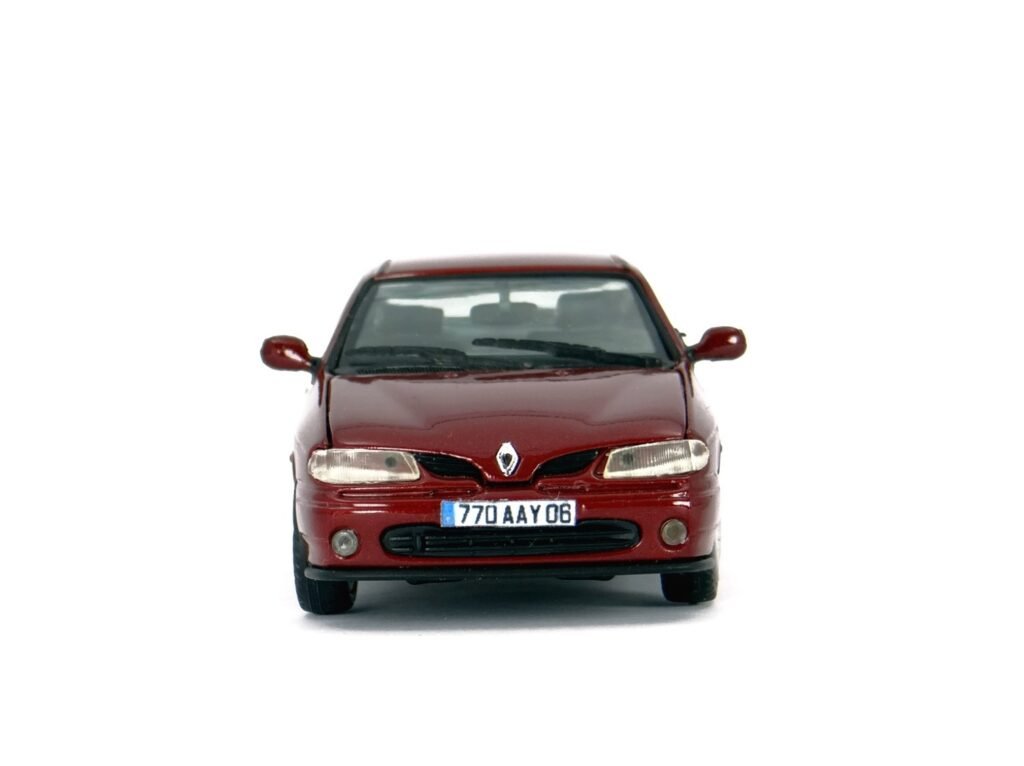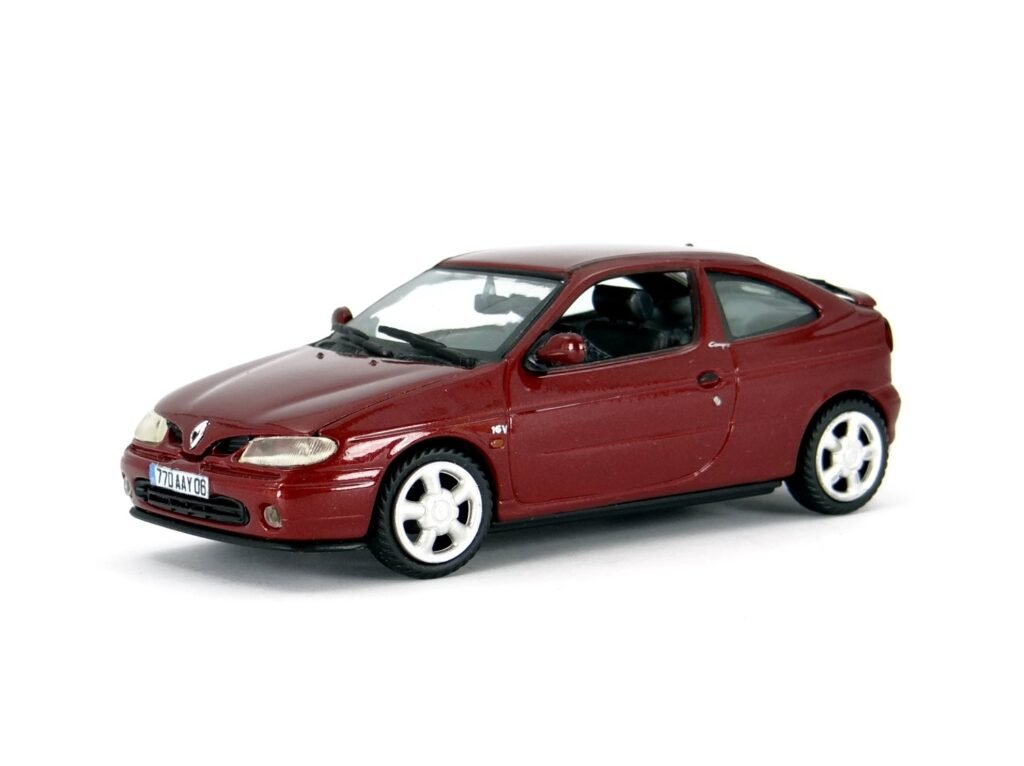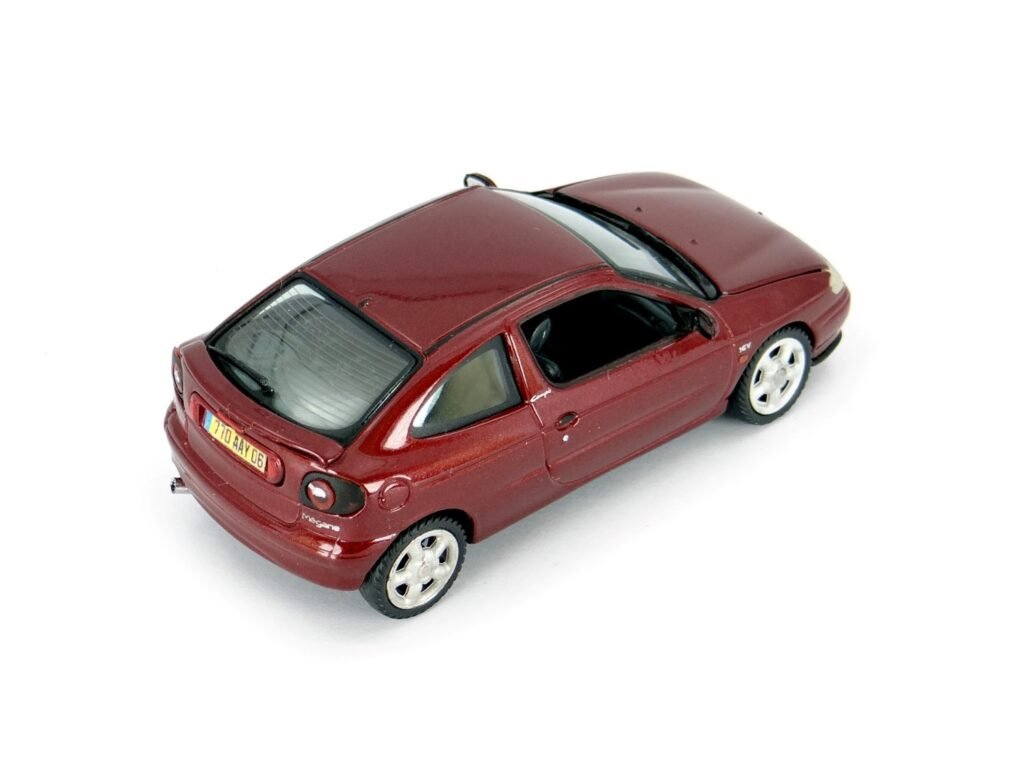Lata 90. przyniosły w Europie wysyp niedużych i przystępnych cenowo coupe. Większość popularnych marek posiadała w swojej ofercie taki model. Mocnym graczem w tym segmencie było na pewno Renault Mégane Coupe.

Już sama nazwa modelu zradza jego pochodzenie. Mégane Coupe bazuje oczywiście na pięciodrzwiowym Mégane, jednak Renault dołożyło starań aby nie była to jedynie jego kolejna wersja nadwoziowa. Coupe niezaprzeczalnie ma swój własny styl. Gdy pojawiło się na rynku w 1996 roku, imponowało swoim modnym wyglądem. Ta zwarta sylwetka z zawadiacką linią bocznych okien wyróżniała się na ulicach lat 90. Szczególnie w jaskrawożółtym kolorze, wygląd Mégane Coupe z łatwością zapadał w pamięć.
Wprawdzie Mégane Coupe korzystało z tej samej płyty podłogowej co inne Mégane, jednak wizualnie bardzo mocno się od nich różniło. Przede wszystkim było znacznie mniejsze. Było aż o 20 cm krótsze (393 cm długości), o 6 cm niższe (136 cm wysokości) i miało o 11 cm mniejszy rozstaw osi (247 cm). Mocniej pochylono także przednią szybę, co podkreślało sportowy charakter tego modelu. W rezultacie, praktycznie każdy panel nadwozia był w wersji coupe unikalny. Nawet przednie reflektory, choć na pierwszy rzut oka takie same jak w innych wersjach nadwoziowych, nieznacznie różnią się kształtem. Dla podkreślenia oryginalności modelu na ramie przednich drzwi umieszczono napis „coupe”. I nie był to absolutnie chwyt marketingowy! Renault Mégane Coupe jest bowiem najprawdziwszym dwudrzwiowym coupe, a nie trzydrzwiowym hatchbackiem tylko je udającym.

W środku ten duch oryginalności dość mocno zanika. Cięcie kosztów trzeba było jednak gdzieś przeprowadzić, dlatego też deskę rozdzielczą w całości przejęto z innych Mégane. Jedyna widoczna różnica to białe tarcze wskaźników. Elementem który w środku najbardziej wyróżniał Mégane Coupe od innych odmian były jego ograniczone możliwości transportowe. Auto mogło na pokładzie pomieścić maksymalnie cztery osoby. Jak na typowe coupe przystało, dwójka pasażerów z przodu miała do dyspozycji wygodne fotele i wystarczającą ilość przestrzeni. Tylna kanapa dla dwojga była jednak bardzo ciasna i zapewniała komfort podróży jedynie dzieciom bądź bardzo niskim dorosłym. Bagażnik też nie należał do dużych (288 l) i co gorsza – dostęp do niego przez malutką klapę był fatalny. Z drugiej strony, trudno to uznać za wielką wadę, wszak nie do roli transportera Mégane Coupe stworzono. Jeśli ktoś potrzebował przestrzeni, w gamie były inne modele.
Mégane Coupe stworzono do tego, aby powodował uśmiech na twarzy i z tego zadania wywiązywał się idealnie. Pomagały w tym zmienione nastawy zawieszenia i układu kierowniczego, które poprawiły prowadzenie względem innych odmian Mégane. W modelu nie stosowano też najsłabszych silników. Gama napędowa składała się z turbodiesla 1.9 dT (95 KM) oraz benzynowych silników 1.6 (90 KM), 2.0 (115 KM) i zerezerwowanego tylko dla coupe i kabrioletu 2.0 16V (150 KM). Szczególnie ta ostatnia jedonstka zasługuje na uwagę. Jest to bowiem ten sam silnik, który wykorzystano w kultowym Clio Williams! Napędzane nim Mégane otrzymało oznaczenie 16V i pełniło rolę topowego modelu w gamie, zastąpując w ofercie Renault model 19 16S.
W 1999 roku razem z resztą gamy Mégane Coupe przeszło lifting a w 2002 ostatecznie zakończono produkcję modelu. Jest to ostatnie, jak na razie, prawdziwe kompaktowe coupe Renult. Bo choć kolejne generacje Mégane posiadały w gamie wersje coupe, były to tak naprawdę tylko trzydrzwiowe hatchbacki.
Przez lata Renault Mégane I Coupe było trochę zapomniane, na szczęście ostatnio zauważono jego potencjał na klasyka. Szczególnie wersje przedliftingowe są w cenie, gdyż w środowisku pasjonatów panuje opinia, że są znacznie ładniejsze.

O miniaturze – Renault Mégane I Coupe
Dzisiaj chciałbym przedstawić Wam model Renault Mégane Coupe w skali 1:43 produkcji Vitesse. Model pochodzi z serii dealerskiej, więc jeśli założyć że został wydany w momencie debiutu samochodu (co jest bardzo prawdopodobne), to ma już 28 lat! Jak wspomniałem w poprzednim wpisie o Renault Espace, produkty Vitesse często budzą mieszane uczucia. Firmie zdarzają się modele przyzwoite, przeciętne jak i słabe. Model Renault Mégane Coupe należy do tej drugiej grupy.
Ogólna bryła miniaturki jest poprawna. Lakier też jest plusem; jest ładny, równy i bez skaz. Największymi bolączkami modelu są natomiast niechlujny montaż i problem z odwzorowaniem detali. Co do niechlujnego montażu, to jest raczej problem całej serii aniżeli konretnego egzemplarza. Miałem w rękach kilka różnych egzemplarzy modelu Renault Mégane Coupe i każdy był inaczej złożony, w każdym coś było krzywo lub odstawało. Akurat mój egzemplarz nie jest pod tym względem taki zły. Ma tylko krzywo zamocowany fotel kierowcy i trochę krzywo wklejone tyle lewe światło.
Jeśli chodzi o odwzorowanie detali to Vitesse jest po prostu niekonsekwentne. Z jednej strony firma zadała sobie mnóstwo trudu aby wiernie odwzorować środek, razem z wzorem tapicerki i wskaźnikami na desce rozdzielczej. Są też oznaczenia „16 V” i „Coupe” na zewnątrz. Z drugiej, zapomniała już o pomalowaniu uszczelek w przednich drzwiach oraz pomalowaniu świateł stopu oraz tylnych odblasków. Obie te rzeczy musiałem domalować sam. Co ciekawe, to czy tylne światła stopu są namalowane czy nie, zależy tyko i wyłącznie od egzemplarza. W moim nie było, ale w innych już tak.
W odbiorze modelu przeszkadza mi też trochę jego przód, bo to chyba jego najgorsza część . Tutaj Vitesse chciało przedobrzyć i w efekcie…strzeliło sobie w stopę. Firma wyposażyła bowiem modelik w otwieraną maskę. Choć oczywiście jest to miły dodatek (i trzeba przyznać, odwzorowanie silnika jest przyzwoite), to skala 1:43 wydaje się za mała do takich szczegółów. W efekcie, szczeliny są zbyt duże, przednia część trochę gubi proporcje i efekct wizualny jest średni.
Pomimo opisanych wyżej niedociągnięć, modelik mi się podoba. To dobrze, bo produkt Vitesse to jedyny model Renault Mégane Coupe w skali 1:43 na rynku, więc wyboru niestety nie ma.
Na koniec, przypominam o odwiedzeniu profilu MiniAutomobile na Facebooku i Instagramie!
*** ENGLISH ***
The 90s brought a wave of small and affordable coupes in Europe. Most of the popular brands had such a model in their line-up. A strong player in this segment was certainly the Renault Mégane Coupe.

The very name of the model reveals its origins. The Mégane Coupe is, of course, based on the five-door Mégane, but Renault made sure it wasn’t just another body version of the same car. The Coupe undeniably has its own style. When it hit the market in 1996, it impressed with its fashionable looks. The compact silhouette with its cheeky side window line stood out on the streets of the 90s. Especially in a bright yellow colour, the Mégane Coupe’s appearance made a lasting impression.
Although the Mégane Coupe shared the same platform as other Mégane models, it was visually quite different from them. First and foremost, it was significantly smaller. It was 20 cm shorter (393 cm in length), 6 cm lower (136 cm in height), and had an 11 cm shorter wheelbase (247 cm). The front windshield was also more slanted, emphasizing the sporty character of the model. As a result, practically every body panel in the coupe was unique. Even the front headlights, although they appeared the same as those on other Méganes at first glance, had a slightly different shape. To highlight the originality of the model, the word “coupe” was placed on the frame of the front doors. And this was certainly no marketing gimmick! The Renault Mégane Coupe is a true two-door coupe, not a three-door hatchback pretending to be one.
Inside, that spirit of originality fades quite a lot. Cost-cutting had to happen somewhere, so the dashboard was entirely borrowed from other Mégane models. The only noticeable difference was the white dials. The feature that mostly distinguished the Mégane Coupe from other versions was its limited transport capacity. The car could carry a maximum of four people. As expected for a typical coupe, the two front passengers had comfortable seats and sufficient space. However, the rear bench for two was very cramped and only offered comfort for children or very short adults. The boot also wasn’t very large (288 litres), and worse – access through the boot lid was dreadful. On the other hand, it’s hard to consider this a major flaw, as the Mégane Coupe was not designed to be a transporter. If someone needed more space, there were other models in the line-up.

The Mégane Coupe was created to bring a smile to your face and it fulfilled this task perfectly. This was aided by the modified suspension settings and steering system, which improved handling compared to other Méganes. The model also didn’t use the weakest engines. The powertrain line-up included the 1.9 dT turbodiesel (95 HP) and petrol engines: 1.6 (90 HP), 2.0 (115 HP) and the 2.0 16V (150 HP), which was reserved exclusively for the coupe and convertible. The latter engine in particular deserves attention. It is the same engine as the one used in the iconic Clio Williams! The Mégane with this engine was labelled 16V and served as the top model in the Mégane range, replacing the Renault 19 16S.
In 1999, along with the rest of the range, the Mégane Coupe underwent a facelift and in 2002, production of the model was finally discontinued. It remains, for now, Renault’s last true compact coupe. Although later generations of the Mégane did offer coupe versions, they were in fact just three-door hatchbacks.
For many years the mk1 Renault Mégane Coupe was somewhat forgotten, but thankfully, its potential as a classic has recently been recognized. Especially the pre-facelift models are in demand, as enthusiasts believe they are much better looking.

About the miniature – Renault Mégane I Coupe
Today, I would like to present you with the model of a Renault Mégane Coupe in 1:43 by Vitesse. The model comes from a dealership edition, so if we assume that it was released at the time of debut of the real car (which is very likely), that makes it 28 years old! As I mentioned in the previous post about the Renault Espace, Vitesse products often evoke mixed feelings among model car collectors. The manufacturer has models that are decent, mediocre as well as poor. The Renault Mégane Coupe model belongs to the second group.
The overall shape of the miniature is correct. The paintwork is also a positive; it is nice, even and blemish-free. However, the biggest issues with the model are its sloppy assembly and problems with detailing. As for the sloppy assembly, it seems to be a problem with the entire series rather than a specific example. I handled several different versions of this Renault Mégane Coupe model and each one was differently put together, with something being crooked or sticking out on each one. Fortunately, my model isn’t that bad in this regard, it only has a crookedly mounted driver’s seat and a slightly misaligned left rear light.
When it comes to detail reproduction, Vitesse is just inconsistent. On one hand, the company put a lot of effort into carefully recreating the interior, including the upholstery pattern and the dials on the dashboard. Outside, there are also the “16 V” and “Coupe” decals. On the other hand, they forgot to paint the rubber trims on the front door and the stop lights and rear reflectors. I had to paint both of these myself. Interestingly, whether the rear stop lights are painted or not depends entirely on the individual model. Mine did not have them, but others did.
What bothers me about the model is also its front end, as it seems to be its weakest part. Here, Vitesse tried to outdo itself and as a result… shot itself in the foot. The manufacturer equipped the model with an opening bonnet. While it’s a nice touch (and I must admit, the engine reproduction is decent), the 1:43 scale seems too small for such details. As a result, the gaps are too wide, the front loses some proportions and the visual effect is mediocre.
Despite the shortcomings mentioned above, I like the model. That’s a good thing because the Vitesse product is the only 1:43 scale Renault Mégane Coupe model on the market! So unfortunately, there’s no other choice.
Lastly, remember to visit MiniAutomobile’s profiles on Facebook and Instagram!

















